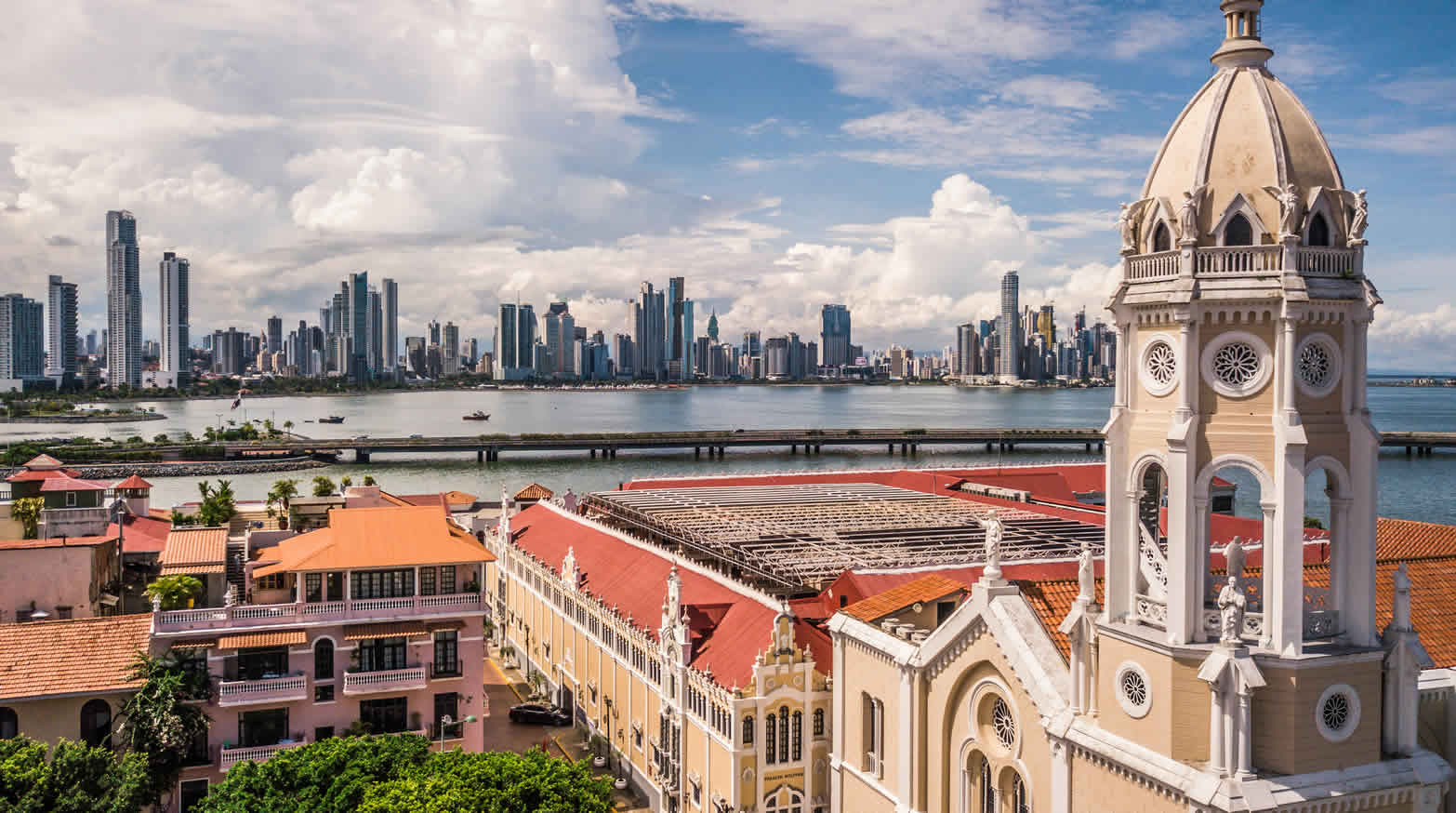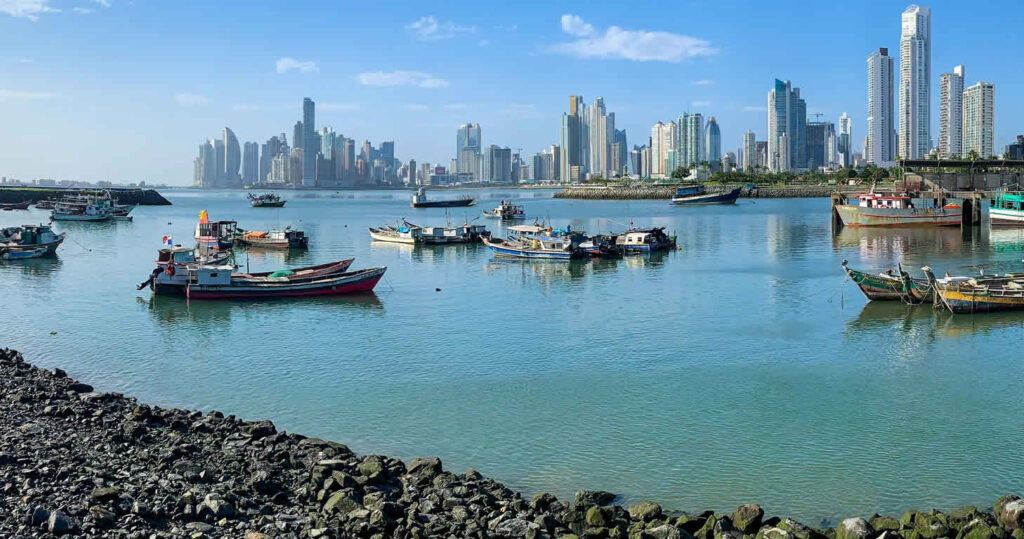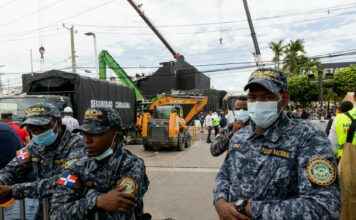Noticias de Panamá
Noticias de última hora de Panamá
Bueno, ¿quién no querría saber las últimas noticias locales de Panamá? La verdad es que a veces parece que en este país pasan cosas más rápido que uno puede parpadear. Desde los últimos chismes de la política hasta esos eventos que parecen sacados de una telenovela, siempre hay algo que está sucediendo. Pero, ¿realmente estamos al tanto de todo? A veces dudo que la gente sepa lo que está pasando a su alrededor. Y es que, si no estás en las redes sociales, parece que te pierdes de todo, ¿no? Las noticias de Panamá son como un buffet libre, uno nunca sabe que va a encontrar. Y claro, no podemos olvidar esos titulares que a veces son más locos que la realidad misma. Así que, si quieres estar al día, o simplemente quieres reírte un rato de lo que ocurre en este hermoso país, sigue leyendo. Hay mucho que comentar y, seguro, te vas a sorprender (o quizás no tanto). ¡Vamos a sumergirnos en las últimas novedades panameñas y ver que nos depara el día!

Las 5 Noticias Más Impactantes de Esta Semana en Panamá
Esta semana, Panamá ha sido testigo de una serie de eventos noticiosos que están generando un gran impacto en la vida de sus ciudadanos. Desde decisiones políticas hasta eventos sociales, estas noticias no solo afectan a la nación, sino que también tienen repercusiones directas en la comunidad local. Aquí te traemos un resumen de las 5 noticias más impactantes de esta semana en Panamá, y cómo podrían influir en tu entorno.
1. Aumento en el Precio de los Combustibles
Uno de los anuncios más preocupantes ha sido el incremento en el precio de los combustibles, que ha subido hasta un 10% en algunos lugares. Esta subida no es solo un número en la pizarra; afecta a todos los panameños, especialmente a aquellos que dependen del transporte público.
- Impacto en el transporte: Los precios de los pasajes podrían aumentar, lo que afecta a trabajadores y estudiantes.
- Inflación: El costo de productos básicos también podría incrementarse debido a los gastos de transporte.
2. Protestas por la Educación Pública
Un grupo de educadores y padres de familia se ha manifestado en la capital, demandando mejoras en la infraestructura escolar y un aumento en el presupuesto destinado a la educación.
- Demandas específicas:
- Mejores condiciones en las aulas.
- Salarios más justos para los maestros.
- Acceso a materiales didácticos adecuados.
Las protestas han atraído la atención de los medios, y los organizadores esperan que el gobierno escuche sus demandas.
3. Crisis de Salud por Dengue
La situación de salud pública se ha vuelto alarmante con un aumento en los casos de dengue. Las autoridades de salud han emitido una alerta, instando a la comunidad a tomar precauciones.
- Estadísticas recientes:
- Aumento del 50% en casos reportados en comparación al año pasado.
- Campañas de fumigación y educación sobre prevención están en marcha.
Las comunidades están siendo afectadas, sobre todo en áreas rurales donde la información sobre cómo prevenir el dengue es limitada.
4. Avances en Proyectos de Infraestructura
El gobierno ha anunciado nuevos proyectos de infraestructura, que incluyen la construcción de puentes y carreteras. Aunque esto parece positivo, hay preocupaciones sobre la gestión de los recursos y la transparencia.
- Beneficios esperados:
- Mejorar el tráfico y la conectividad.
- Crear empleo local durante la construcción.
Sin embargo, los ciudadanos se preguntan si estos proyectos se llevaran a cabo de forma eficiente y si realmente beneficiaran a las comunidades afectadas.
5. Desarrollo Sostenible y Cambio Climático
La discusión sobre el cambio climático ha tomado fuerza esta semana, con un nuevo informe que destaca cómo Panamá es vulnerable a desastres naturales. La comunidad está empezando a tomar conciencia sobre la importancia de la sostenibilidad.
- Iniciativas locales:
- Programas de reforestación.
- Talleres sobre reciclaje y reducción de residuos.
Estas iniciativas son cruciales, ya que muchos panameños aún no entienden la relación entre el cambio climático y su vida diaria.
¿Cómo Afectan Estas Noticias a Tu Comunidad?
Lo más importante es que cada una de estas noticias tiene un impacto directo en la vida cotidiana de los panameños. Aquí hay algunas maneras en que podrías sentir sus efectos:
- Economía local: El aumento de precios puede llevar a una menor capacidad de compra.
- Salud pública: La crisis del dengue es un recordatorio de la necesidad de atención médica adecuada y prevención en las comunidades.
- Participación ciudadana: Las protestas y la discusión sobre la educación instan a la ciudadanía a involucrarse más en temas importantes.
- Inversión en infraestructura: Aunque puede generar empleo, también trae consigo la necesidad de supervisión y transparencia.
Los ciudadanos deben estar informados sobre estas noticias para que puedan participar activamente en la discusión y abogar por cambios positivos en sus comunidades. Mantente atento a las últimas noticias locales de Panamá para estar al tanto de cómo estas situaciones están evolucionando y qué significan para ti y tu entorno.

¿Qué Está Pasando en Panamá? Últimas Noticias Locales que No Te Puedes Perder
En las últimas semanas, Panamá ha estado en el centro de varias noticias que están impactando a la comunidad local. Desde cambios políticos hasta eventos culturales, hay mucho que discutir. Pero, ¿qué está pasando en Panamá? Aquí te traemos las últimas noticias locales que no te puedes perder.
Cambios en el Gobierno y su Impacto
Recientemente, el gobierno panameño ha tomado decisiones que podrían afectar a muchos ciudadanos. Por ejemplo, se han implementado nuevas políticas fiscales que buscan mejorar la economía. Algunas de estas decisiones incluyen:
- Aumento de impuestos a ciertos sectores.
- Reducción de subsidios a productos básicos.
- Nuevas regulaciones para el comercio local.
Estos cambios han generado opiniones divididas entre los ciudadanos. Algunos creen que son necesarios para el desarrollo del país, mientras que otros sienten que perjudica a las familias de clase baja. Es esencial que los panameños se mantengan informados sobre cómo estas decisiones pueden afectar su día a día.
La Cultura Panameña en el Centro de Atención
La cultura panameña también ha estado en el foco de atención. Con eventos como la Feria de las Flores y del Café, que se celebró recientemente, se está promoviendo el arte y las tradiciones del país. Este evento no solo atrae a turistas, sino que también fomenta el orgullo local.
Algunos puntos destacados de la feria incluyen:
- Exhibiciones de artesanía local.
- Música y danzas tradicionales.
- Gastronomía panameña en su mejor expresión.
La participación de artistas locales en estos eventos es crucial para mantener vivas las tradiciones y, además, para la economía. Los emprendedores locales tienen una gran oportunidad en ferias como esta.
Problemas Sociales que Afectan a la Comunidad
La desigualdad social sigue siendo un problema importante en Panamá. Hay una creciente preocupación por la falta de acceso a educación y salud en ciertas áreas. Según informes recientes:
- El 20% de la población vive en condiciones de pobreza extrema.
- Hay una gran diferencia en la calidad de la educación entre las áreas urbanas y rurales.
Es fundamental que las autoridades aborden estos problemas para asegurar un futuro más equitativo para todos los panameños. La comunidad debe estar atenta a las iniciativas que se tomen al respecto.
La Situación Económica Actual
La economía de Panamá ha enfrentado retos debido a la pandemia y la inflación global. Aunque el país tiene un crecimiento relativamente bueno, todavía hay sectores que no se han recuperado completamente. Algunas de las principales preocupaciones económicas incluyen:
- Desempleo que sigue afectando a muchos.
- Aumento en el costo de vida, que ha hecho que muchos ciudadanos consideren alternativas para sobrevivir.
- Inversión extranjera que ha disminuido en ciertos sectores.
Los ciudadanos deben mantenerse informados sobre cómo estos factores pueden impactar sus finanzas personales y su capacidad de ahorro.
Noticias Deportivas que Inspiran
El deporte también ha sido un tema importante en Panamá. La selección nacional de fútbol ha tenido un papel destacado en la región, lo que ha unido a la población. Recientemente, se celebraron partidos de eliminatorias para la Copa Mundial, y la emoción fue palpable en las calles.
Además, otros deportes como el béisbol y el baloncesto también están ganando popularidad. Equipos locales están compitiendo a niveles más altos, lo que da esperanza a los jóvenes deportistas. En este sentido, es fundamental el apoyo de la comunidad para fomentar el talento emergente.
Eventos y Actividades Locales a No Perderse
Panamá también ofrece una variedad de eventos y actividades que vale la pena explorar. Algunos de los más destacados incluyen:
- Conciertos de música local: una excelente manera de disfrutar de la cultura musical panameña.
- Festivales gastronómicos: donde se puede degustar la variada comida del país.
- Talleres de arte y manualidades: ideales para quienes buscan aprender nuevas habilidades.
Estos eventos no solo promueven la cultura, sino que también fortalecen las relaciones comunitarias.
Los cambios en Panamá son constantes y reflejan una sociedad en evolución. Es importante que todos los panameños se mantengan informados sobre las últimas noticias locales, ya que estas impactan directamente en sus vidas y comunidades. Desde la política hasta la cultura, cada noticia es una pieza del rompecabezas que forma el panorama actual del país.
Descubre los Proyectos de Infraestructura en Panamá
Panamá, un país conocido por su Canal y su rica historia cultural, está en medio de una ola de proyectos de infraestructura que prometen transformar su paisaje urbano y rural. Sin embargo, estos desarrollos traen consigo una serie de beneficios y problemas que impactan directamente a los vecinos. En este artículo, analizamos los últimos proyectos de infraestructura en Panamá y cómo estos afectan a las comunidades locales.
Proyectos en Marcha
Los proyectos de infraestructura en Panamá son variados y abarcan desde la construcción de carreteras hasta la expansión del metro en la Ciudad de Panamá. Algunos de los más destacados incluyen:
- Ampliación de la Línea 1 del Metro: Este proyecto busca extender la red de transporte público, lo que facilitaria el desplazamiento de miles de ciudadanos diariamente.
- Construcción de Nuevas Carreteras: Varias vías nuevas se están haciendo en el interior del país, buscando mejorar la conectividad entre comunidades.
- Proyectos de Agua Potable: La inversión en sistemas de agua potable es vital para mejorar la calidad de vida de muchos panameños.
Beneficios para la Comunidad
La mayoría de los proyectos de infraestructura traen consigo una serie de beneficios que son difíciles de ignorar. Algunos de estos beneficios son:
- Mejora en el Transporte: Con el metro y nuevas carreteras, el tiempo de viaje se reduce significativamente, lo que puede mejorar la productividad.
- Creación de Empleo: La construcción de infraestructuras genera miles de empleos, lo que puede ser vital en un país con altos índices de desempleo.
- Desarrollo Económico: Al mejorar la infraestructura, se facilita el comercio y la inversión, lo que puede resultar en un crecimiento económico sostenido.
Problemas que Surgen
No obstante, no todo es positivo. Muchos vecinos expresan su preocupación por los problemas que estos proyectos pueden traer. Algunos de ellos incluyen:
- Desplazamiento de Comunidades: La construcción de nuevas carreteras o edificios a veces requiere que las familias se muden, lo que puede causar un desarraigo significativo.
- Contaminación: Los proyectos de construcción suelen generar ruido, polvo y otros tipos de contaminación que afectan la calidad de vida de los residentes cercanos.
- Aumento de Costos: A medida que las áreas se desarrollan, los precios de vivienda y servicios pueden aumentar, haciendo que la vida sea más cara para los habitantes locales.
¿Qué Dicen los Vecinos?
Los residentes de Panamá tienen opiniones diversas sobre los proyectos de infraestructura. Algunos creen que los beneficios superan a los problemas, mientras que otros están preocupados por el impacto negativo en sus vidas. Aquí algunas opiniones recogidas:
- «El metro es una gran idea. Pero, ¿quién se preocupa por las familias que se ven obligadas a mudarse?»
- «Las nuevas carreteras son necesarias, pero el ruido y la contaminación son insoportables.»
- «Me alegra ver inversión en mi comunidad, pero espero que no olviden a quienes viven aquí desde hace años.»
Últimas Noticias Locales de Panamá
Mantente informado sobre las últimas noticias locales en Panamá, ya que estos proyectos están en constante evolución. Aquí algunas fuentes para seguir:
- Diario La Prensa: Ofrece actualizaciones regulares sobre los proyectos de infraestructura y sus efectos.
- TVN Noticias: Proporciona reportajes y análisis sobre cómo estos cambios impactan a las comunidades.
- Panamá América: Un sitio web que cubre noticias locales, incluyendo los últimos desarrollos en infraestructura.
Comparación de Proyectos
Para entender mejor el impacto de estos proyectos, es útil comparar diferentes iniciativas. A continuación, se presenta una tabla simple que muestra algunos de los principales proyectos y sus respectivos beneficios y problemas.
| Proyecto | Beneficios | Problemas |
|---|---|---|
| Ampliación del Metro | Mejora del transporte público | Desplazamiento de vecinos |
| Nuevas Carreteras | Conectividad aumentada | Contaminación y ruido |
| Proyectos de Agua Potable | Acceso a agua limpia | Costos de vida en aumento |
Este tipo de análisis permite que los ciudadanos comprendan mejor las implicaciones de los cambios que se realizan en su entorno.
Los proyectos de infraestructura en Panamá son sin duda un tema caliente que afecta a muchas comunidades. Mientras que algunos ven una oportunidad para el crecimiento, otros sienten que sus vidas se alteran de maneras preocupantes. La clave está en encontrar un equilibrio que beneficie a todos los panameños.

Crisis Económica en Panamá: 7 Consecuencias Clave para las Familias Locales
La crisis económica en Panamá ha tomado un rumbo preocupante, afectando a miles de familias en todo el país. Según los últimos informes, la situación se ha agravado en los últimos meses, dejando huellas visibles en la vida diaria de los panameños. Este artículo explora siete consecuencias clave que las familias están enfrentando debido a esta crisis y proporciona un análisis de cómo está impactando las comunidades locales.
Aumento del Costo de Vida
Uno de los efectos más notables de la crisis económica es el aumento del costo de vida. Los precios de alimentos básicos, como el arroz y los frijoles, han subido drásticamente. Esto ha llevado a muchas familias a reducir sus gastos y priorizar qué alimentos comprar. En algunos casos, las familias reportan que han tenido que cambiar su dieta a opciones más baratas y menos nutritivas.
- Ejemplos de aumento de precios:
- Arroz: de $0.90 a $1.20 por libra.
- Frijoles: de $1.50 a $2.00 por libra.
- Aceite: de $3.00 a $4.00 por litro.
Desempleo en Aumento
El desempleo ha aumentado considerablemente. Muchas empresas han cerrado o reducido su personal, lo que ha dejado a muchos panameños sin trabajo. Las cifras oficiales indican que la tasa de desempleo ha subido al 12%, una cifra alarmante que afecta sobre todo a jóvenes y trabajadores informales. Las familias se ven obligadas a buscar múltiples fuentes de ingresos, a menudo en trabajos de baja remuneración.
Acceso Limitado a Servicios de Salud
La crisis no solo impacta la economía, también afecta el acceso a servicios de salud. Con la reducción de ingresos, las familias tienen dificultad para pagar seguros médicos y consultas. Esto ha resultado en un aumento de enfermedades no tratadas, que pueden convertirse en problemas de salud más graves a largo plazo.
- Estadísticas de salud:
- 40% de la población sin acceso a atención médica adecuada.
- Aumento del 15% en enfermedades crónicas no tratadas.
Educación Afectada
La crisis también ha hecho que muchos padres no pueden pagar la educación de sus hijos. Las matrículas escolares han incrementado, y en algunos casos, las familias han tenido que optar por retirar a sus hijos de la escuela o buscar alternativas educativas más económicas. Esto tiene repercusiones a largo plazo en la formación de la juventud panameña.
Migración Aumentada
La desesperación económica ha llevado a un aumento en la migración de panameños hacia otros países en busca de mejores oportunidades. Muchos jóvenes están eligiendo dejar sus hogares y buscar trabajo en el extranjero, lo que está desintegrando comunidades y familias. Esto crea un ciclo de desarraigo que afecta el tejido social del país.
Inseguridad Alimentaria
Con el aumento en el costo de vida y la disminución de ingresos, la inseguridad alimentaria se ha vuelto una realidad para muchas familias. Las organizaciones locales han reportado un incremento en la cantidad de personas que dependen de comedores comunitarios y donaciones de alimentos. Esto no solo afecta la salud física de los panameños, sino también su bienestar emocional.
Estrés Financiero y Salud Mental
La presión económica está generando un aumento en los problemas de salud mental. Muchas familias están lidiando con el estrés y la ansiedad debido a la incertidumbre financiera. La falta de recursos para buscar ayuda profesional agrava aún más la situación. Las líneas de ayuda y los servicios de consejería están sobrecargados, y muchos no reciben la atención que necesitan.
Respuesta de la Comunidad
Las comunidades han comenzado a organizarse para enfrentar la crisis. Existen iniciativas comunitarias que buscan proporcionar apoyo a familias necesitadas a través de donaciones, programas de capacitación laboral y acceso a servicios de salud. Estas acciones son vitales para ayudar a mitigar los efectos de la crisis, aunque los recursos son limitados.
- Iniciativas comunitarias:
- Comedores comunitarios.
- Talleres de capacitación en habilidades laborales.
- Redes de apoyo psicológico.
La crisis económica en Panamá está afectando a las familias de maneras profundas y variadas. Desde el aumento del costo de vida hasta problemas de salud mental, las repercusiones son múltiples. La comunidad está tratando de adaptarse y encontrar soluciones, pero es evidente que se necesita un compromiso tanto del gobierno como de la sociedad civil para abordar estos problemas de manera efectiva y sostenible. La situación actual es un llamado a la acción para todos los panameños, recordando que la unidad y la solidaridad son más importantes que nunca.
Salud y Bienestar: Las Últimas Noticias que Están Transformando el Sistema de Salud en Panamá
La salud y bienestar en Panamá están en constante evolución, y las últimas noticias locales reflejan cambios significativos que impactan a comunidades por toda la nación. En un contexto donde la salud pública se ha vuelto un tema crucial, entender cómo estos cambios afectan a la población es vital para todos. En este artículo, exploraremos las novedades más importantes en el sistema de salud panameño y cómo esto repercute en la vida diaria de los ciudadanos.
Cambios Recientes en la Política de Salud
Recientemente, el gobierno panameño ha implementado varias políticas nuevas para mejorar el acceso a los servicios de salud. Algunas de estas iniciativas incluyen:
- Ampliación de servicios de salud pública: Se han abierto nuevos centros de salud en áreas rurales donde antes no había acceso.
- Programas de prevención: Iniciativas centradas en la prevención de enfermedades crónicas como diabetes y hipertensión.
- Colaboraciones internacionales: Panamá ha firmado acuerdos con otros países para mejorar la formación de profesionales de la salud.
Estos cambios son fundamentales, pero no todos los ciudadanos están al tanto de ellos. La información muchas veces no llega a las comunidades más necesitadas.
Impacto de la Tecnología en el Sistema de Salud
La digitalización también está transformando el sector salud en Panamá. Se han visto avances significativos en la adopción de tecnologías para mejorar la atención médica. Esto incluye:
- Telemedicina: Ahora los pacientes pueden consultar a sus médicos desde la comodidad de sus hogares, lo que es especialmente útil para personas en áreas remotas.
- Expedientes médicos electrónicos: Facilitan el acceso a la información del paciente, mejorando la continuidad del cuidado.
- Aplicaciones de salud: Hay aplicaciones que permiten a los ciudadanos monitorear su salud y gestionar citas médicas.
Sin embargo, la brecha digital sigue siendo un desafío. No todas las personas tienen acceso a internet o dispositivos adecuados, lo que limita el alcance de estas innovaciones.
Problemas de Salud Pública
A pesar de los avances, hay problemas persistentes que afectan a la población panameña. Algunos de los desafíos más notables incluyen:
- Enfermedades transmitidas por vectores: Aún hay un alto número de casos de dengue y malaria en ciertas regiones.
- Desnutrición: Aunque el país ha progresado, la desnutrición infantil sigue siendo un problema en comunidades vulnerables.
- Acceso desigual a medicamentos: En algunas áreas, la falta de medicamentos esenciales sigue siendo un reto.
Noticias Locales que Impactan a Tu Comunidad
Las últimas noticias locales de Panamá están llenas de historias que reflejan cómo la salud y bienestar son temas prioritarios. Algunos ejemplos incluyen:
- Campañas de vacunación: Localidades están organizando eventos para aumentar la tasa de vacunación entre los niños.
- Charlas de salud comunitarias: A menudo se realizan talleres para educar a la población sobre hábitos saludables.
- Proyectos de saneamiento: Mejoras en infraestructuras de agua y saneamiento están en marcha en varias comunidades.
Estos esfuerzos son cruciales, ya que la salud pública no solo depende de las instituciones, sino también de la participación activa de la comunidad.
Comparación Regional de Salud
Es interesante ver cómo Panamá se compara con otros países de la región en términos de salud. Aquí hay una tabla que muestra algunos indicadores clave:
| Indicador | Panamá | Costa Rica | Colombia |
|---|---|---|---|
| Esperanza de vida | 78 años | 81 años | 77 años |
| Tasa de mortalidad infantil | 11 por cada 1000 | 8 por cada 1000 | 13 por cada 1000 |
| Acceso a agua potable | 95% | 100% | 88% |
Como se observa, Panamá tiene áreas donde mejora, pero también retos a superar. La colaboración con otros países puede ser un camino hacia el desarrollo.
Salud Mental: Un Tema Emergente
Un área que ha ganado atención recientemente es la salud mental. La pandemia de COVID-19 ha dejado huellas profundas en la salud emocional de las personas. Se han implementado programas para abordar estos problemas, como:
- Líneas de ayuda: Servicios de apoyo psicológico están disponibles para quienes lo necesiten.
- Talleres de manejo del estrés: Se están ofreciendo en varias comunidades.
- Educación sobre salud mental: Campañas para desestigmatizar el tema y promover el bienestar emocional.
La salud mental es un aspecto esencial del bienestar, y es crucial que se le preste atención.
Con el panorama de salud y bienestar en Panamá en constante cambio, es importante que todos estén informados y participen en estas iniciativas. Las decisiones que se tomen
Educación en Panamá: Nuevas Iniciativas que Impactan a Estudiantes y Padres
La educación en Panamá ha estado en el centro del debate en los últimos años, especialmente con el lanzamiento de nuevas iniciativas que buscan mejorar la calidad educativa y el acceso para todos los estudiantes. En este artículo, exploramos las últimas noticias locales de Panamá y cómo estas iniciativas impactan a los estudiantes y a sus familias.
Nuevas Iniciativas Educativas
El gobierno panameño ha implementado varias estrategias que buscan transformar el sistema educativo. Entre estas iniciativas, se encuentran:
- Programas de Becas: Se estan ofreciendo becas para estudiantes de bajos recursos, permitiendo que más jóvenes accedan a la educación superior.
- Capacitación Docente: Los maestros reciben formación continua para mejorar sus métodos de enseñanza, lo que impacta directamente en el aprendizaje de los alumnos.
- Inversión en Infraestructura: La construcción y renovación de escuelas es una prioridad, buscando crear espacios más amigables y accesibles para los estudiantes.
Estas iniciativas no solo buscan incrementar la tasa de graduación, sino también fomentar un ambiente donde el aprendizaje sea más efectivo y atractivo.
Impacto en la Comunidad
Las últimas noticias locales de Panamá han mostrado que no solo los estudiantes se benefician de estas reformas, sino también los padres. Esto es lo que ha cambiado en las comunidades:
- Mayor Participación de los Padres: Hay un creciente involucramiento de los padres en las actividades escolares, lo que ayuda a crear una comunidad educativa más sólida.
- Apoyo Psicológico: Se han implementado programas de apoyo emocional para estudiantes y padres, ayudando a manejar el estrés y la ansiedad relacionados con el estudio.
- Actividades Extracurriculares: Se han creado más oportunidades para que los estudiantes participen en actividades fuera del aula, como deportes y arte, lo que promueve un desarrollo integral.
Esto ha generado un clima de colaboración, donde las familias y escuelas trabajan juntas por el bienestar de los jóvenes.
Desafíos Persistentes
A pesar de los avances, aún hay muchos desafíos que enfrentan las iniciativas educativas en Panamá:
- Desigualdad Regional: Las áreas rurales todavía enfrentan problemas de acceso a recursos educativos, lo que genera una brecha.
- Falta de Recursos: Muchas escuelas carecen de materiales básicos, lo que dificulta el proceso de enseñanza.
- Resistencia al Cambio: Algunos educadores y padres se sienten inseguros ante las nuevas metodologías y programas, lo que puede obstaculizar la implementación efectiva.
Esto muestra que aunque hay progreso, la lucha por una educación de calidad es un camino largo y lleno de obstáculos.
Comparación con Otros Países de la Región
Panamá no es el único país en la región que está tratando de mejorar su sistema educativo. Aquí hay un vistazo a cómo se compara con otros países de Centroamérica:
| País | Iniciativas Clave | Desafíos Principales |
|---|---|---|
| Panamá | Programas de becas, capacitación docente | Desigualdad regional |
| Costa Rica | Educación gratuita y obligatoria | Infraestructura envejecida |
| Honduras | Proyectos de alfabetización | Alta tasa de deserción escolar |
| Nicaragua | Inversión en tecnología educativa | Falta de formación docente |
Como se puede ver, cada país enfrenta sus propios retos, pero muchos comparten el objetivo de mejorar la calidad educativa.
Ejemplos de Éxitos Locales
En varias comunidades de Panamá, se han logrado historias de éxito que ejemplifican el impacto positivo de las nuevas iniciativas:
- Escuela La Esperanza: Implementó un programa de tutoría que ha aumentado las calificaciones en un 20% en solo un año.
- Proyecto Futuro Brillante: Este programa ha proporcionado becas a más de 500 estudiantes de comunidades vulnerables, permitiendo que continúen sus estudios.
- Iniciativa de Arte y Cultura: Al asociarse con artistas locales, las escuelas han podido ofrecer cursos de arte, mejorando la creatividad y el compromiso de los estudiantes.
Estos ejemplos demuestran que con el esfuerzo adecuado, los cambios positivos son posibles.
A medida que Panamá continúa desarrollando su sistema educativo, es crucial que las comunidades se mantengan informadas sobre las últimas noticias locales de Panamá y participen activamente en el proceso. Solo así se podrá asegurar que las nuevas iniciativas beneficien a todos los estudiantes y sus familias. Cada paso hacia adelante es un paso hacia un futuro mejor para la educación en el país.
El Cambio Climático en Panamá: Últimas Noticias sobre sus Efectos Locales y Soluciones Sostenibles
El Cambio Climático en Panamá: Últimas Noticias sobre sus Efectos Locales y Soluciones Sostenibles
Panamá, un país conocido por su biodiversidad y su famoso canal, enfrenta desafíos graves debido al cambio climático. Las últimas noticias locales sobre este tema son preocupantes, ya que las comunidades están experimentando cambios en su entorno que afectan la vida diaria de sus habitantes. Desde el aumento del nivel del mar hasta cambios en las estaciones de lluvia, el impacto del calentamiento global se siente en cada rincón del país.
Efectos del Cambio Climático en Panamá
La realidad del cambio climático en Panamá no es solo una teoría, es un problema que ya está afectando a muchas comunidades. Aquí algunos de los efectos más notables:
- Aumento de la Temperatura: Según estudios recientes, la temperatura promedio en Panamá ha subido entre 1°C y 2°C en los últimos 50 años. Esto afecta la agricultura y la salud pública.
- Sequías Más Severas: Las temporadas de sequía se están volviendo más frecuentes y duraderas, lo que pone en riesgo la producción de alimentos y el acceso al agua potable.
- Inundaciones: Por otro lado, hay lluvias intensas que provocan inundaciones. Las comunidades costeras, como Colón y Chiriquí, son especialmente vulnerables.
- Desplazamiento de Especies: La fauna y flora locales están cambiando, algunas especies están desapareciendo mientras que otras invaden nuevos hábitats.
Últimas Noticias Locales de Panamá: ¿Qué Impacta Tu Comunidad?
Las noticias locales en Panamá están llenas de reportes sobre cómo el cambio climático está impactando las comunidades. Aquí hay algunos ejemplos recientes:
- Campañas de Concientización: Varias organizaciones no gubernamentales han lanzado iniciativas para educar a la población sobre la importancia de la sostenibilidad y la reducción de la huella de carbono.
- Proyectos de Infraestructura Verde: El gobierno ha comenzado a implementar proyectos de infraestructura verde, como techos verdes y sistemas de drenaje sostenibles, para mitigar el impacto de las lluvias intensas.
- Reforestación: Se están realizando esfuerzos de reforestación en áreas afectadas por la deforestación, lo que ayuda a restaurar ecosistemas y mejorar la calidad del aire.
Soluciones Sostenibles para el Cambio Climático
Aunque los desafíos son grandes, Panamá tiene varias soluciones sostenibles que pueden ayudar a enfrentar el cambio climático. Algunas de estas soluciones incluyen:
- Energías Renovables: Invertir en energía solar y eólica podría reducir la dependencia de combustibles fósiles. Panamá tiene un gran potencial para la energía solar debido a su ubicación geográfica.
- Agricultura Sostenible: Promover técnicas agrícolas que son amigables con el medio ambiente puede ayudar a asegurar la producción de alimentos en un clima cambiante. Esto incluye la rotación de cultivos y el uso de pesticidas naturales.
- Educación Ambiental: La educación juega un papel clave en la lucha contra el cambio climático. Programas en escuelas y comunidades pueden ayudar a las personas a entender cómo sus acciones impactan el medio ambiente.
- Conservación de Recursos Hídricos: Es importante implementar sistemas de recolección de agua de lluvia y promover el uso eficiente del agua para enfrentar las sequías.
Comparación con Otros Países de la Región
Es interesante ver como Panamá se compara con otros países de América Central en términos de su respuesta al cambio climático. Por ejemplo:
- Costa Rica: Ha liderado en la reforestación y uso de energías renovables, generando más del 99% de su electricidad a partir de fuentes renovables.
- Honduras: Enfrenta problemas severos de deforestación y desastres naturales, pero ha comenzado a desarrollar políticas para mejorar su resiliencia climática.
Ejemplos Prácticos de Iniciativas Locales
Algunas comunidades en Panamá han tomado la iniciativa para adaptarse a la nueva realidad climática. Ejemplos incluyen:
- Cooperativas de Agricultores: Se han formado para compartir recursos y conocimientos sobre cómo cultivar en condiciones climáticas adversas.
- Proyectos de Energía Solar Comunitaria: Algunas aldeas han implementado sistemas de energía solar para reducir costos y mejorar la sostenibilidad.
La situación climática en Panamá es crítica, pero con la colaboración de todos los sectores de la sociedad, incluyendo gobiernos, organizaciones y ciudadanos, se pueden encontrar soluciones efectivas. La clave está en actuar ahora y adoptar prácticas sostenibles que beneficien a las futuras generaciones.
¿Cómo Afectan las Nuevas Leyes a los Ciudadanos Panameños? Un Análisis de las Últimas Noticias
Las recientes reformas legales en Panamá han generado un gran debate en la sociedad. Muchos panameños se preguntan cómo estas nuevas leyes afectan su vida diaria y qué impacto tendrán en sus comunidades. En este análisis, exploraremos las últimas noticias locales de Panamá, centrándonos en las implicaciones que estas reformas tienen para los ciudadanos.
Cambios en el Sistema de Salud
Una de las leyes más discutidas recientemente es la reforma al sistema de salud pública. Esta medida busca mejorar el acceso a servicios médicos, pero hay preocupaciones sobre su efectividad. Algunos puntos claves incluyen:
- Aumento de la financiación: Se ha prometido más recursos para hospitales y clínicas.
- Mejora en la infraestructura: Se planea modernizar instalaciones médicas.
- Capacitación de personal: Se requerirá más capacitación para médicos y enfermeras.
Sin embargo, críticos argumentan que la implementación de estas reformas será un desafío y que se necesita más claridad sobre cómo se llevarán a cabo.
Educación y Nuevas Normativas
Otra área que ha visto cambios significativos es la educación. Las nuevas leyes afectan desde la educación primaria hasta la universitaria. Algunos de los cambios incluyen:
- Aumento del presupuesto educativo: El gobierno dice que destinará más fondos a las escuelas.
- Currículo actualizado: Se introducirán materias nuevas, como programación y educación financiera.
- Enfoque en la inclusión: Se busca que más niños con discapacidades tengan acceso a la educación.
No obstante, muchos padres se preocupan sobre cómo se implementarán estas leyes en la práctica y si realmente beneficiarán a sus hijos.
Leyes Laborales y Derechos de los Trabajadores
Las últimas reformas laborales también han sido un tema candente. Se han introducido regulaciones que buscan proteger a los trabajadores y mejorar sus condiciones laborales. Entre las más importantes se encuentran:
- Aumento del salario mínimo: Se ha propuesto un aumento gradual del salario mínimo.
- Más derechos a los trabajadores temporales: Los empleados temporales ahora tienen derechos adicionales.
- Regulación de horas extra: Se establecerán límites más estrictos sobre las horas de trabajo.
Esto ha generado reacciones mixtas. Algunos ven estas medidas como un avance, mientras que otros temen que puedan llevar a un aumento del desempleo si las empresas no pueden adaptarse.
Impacto en la Seguridad Ciudadana
La seguridad ha sido un tema crítico y las nuevas leyes también abordan este problema. Las propuestas incluyen:
- Aumento de la policía en las calles: Se planea más presencia policial en áreas conflictivas.
- Inversión en tecnología: Se utilizará tecnología para mejorar la vigilancia y la respuesta a delitos.
- Programas de rehabilitación: Se están introduciendo programas para reintegrar a delincuentes a la sociedad.
Pese a esto, la percepción de la seguridad en Panamá sigue siendo un tema controvertido. Muchos ciudadanos sienten que la violencia sigue siendo un problema grave.
Comparación con Leyes Anteriores
Es útil comparar las nuevas leyes con las anteriores para entender mejor su impacto. A continuación, se presenta una tabla simplificada sobre algunas de las reformas:
| Aspecto | Ley Anterior | Nueva Ley |
|---|---|---|
| Salud | Acceso limitado | Mayor financiación y acceso |
| Educación | Currículo rígido | Currículo actualizado y variado |
| Trabajo | Derechos limitados | Más derechos y aumento de salario |
| Seguridad | Enfoque reactivo | Enfoque proactivo y preventivo |
Opiniones de la Comunidad
Las opiniones de los ciudadanos son variadas. Algunos sienten que estos cambios son un paso adelante, mientras que otros son escépticos. Por ejemplo, un grupo de maestros expresa su esperanza por las nuevas normativas educativas, pero también manifiestan que la implementación será clave. Por otro lado, en foros comunitarios, los trabajadores discuten las posibles repercusiones de las reformas laborales.
Últimas Noticias Locales de Panamá
Es importante mantenerse actualizado sobre los desarrollos en estas áreas. Las últimas noticias locales de Panamá se pueden seguir a través de medios de comunicación, redes sociales y foros comunitarios. Esto ayuda a los ciudadanos a estar informados sobre cómo las leyes afectan su vida diaria y a participar en el diálogo sobre el futuro de su país.
En resumen, las nuevas leyes en Panamá están diseñadas para mejorar la calidad de vida de sus ciudadanos, pero la implementación y la efectividad de estas reformas son cuestiones cruciales que seguirán desarrollándose en los próximos meses. Los panameños deben estar atentos y participar activamente en el proceso para asegurar que sus intereses sean representados y protegidos en esta nueva era legislativa.
Cultura y Tradición: Las Últimas Noticias Locales que Celebran la Diversidad en Panamá
La cultura y la tradición son pilares fundamentales en Panamá, un país caracterizado por su diversidad étnica y cultural. Las últimas noticias locales reflejan cómo estas tradiciones no solo se conservan, sino que también se celebran en la cotidianidad de los panameños. Desde festivales coloridos hasta costumbres ancestrales, cada rincón de Panamá aporta a un mosaico cultural vibrante que merece ser explorado.
Celebraciones que Unen
Uno de los eventos más esperados en el calendario cultural panameño es el Carnaval. Esta celebración, que se realiza antes de la Cuaresma, involucra desfiles llenos de música, baile y disfraces espectaculares. Cada año, las ciudades como Las Tablas y Santiago se convierten en el epicentro de las festividades, donde tanto locales como turistas se unen para disfrutar de la alegría y el ritmo contagioso de la música típica.
- Carnaval de Las Tablas: Famoso por sus comparsas y el derroche de creatividad en los trajes.
- Carnaval de Santiago: Un enfoque más familiar, con actividades para todos los públicos.
Además, el Festival de la Mejorana en Guararé es otro ejemplo de cómo la cultura se vive intensamente en Panamá. Este festival se dedica a la música folclórica y la danza, promoviendo las tradiciones que han sido transmitidas de generación en generación.
Impacto en la Comunidad
Las últimas noticias locales de Panamá destacan cómo estas tradiciones impactan las comunidades. La preservación de la cultura no solo fomenta un sentido de identidad, sino que también genera oportunidades económicas a través del turismo. Las comunidades que participan en festivales y eventos culturales a menudo ven un aumento en el número de visitantes, lo que beneficia a los negocios locales.
- Turismo cultural: Atrae a visitantes que buscan experiencias auténticas.
- Economía local: Las ferias y mercados artesanales ofrecen productos típicos y apoyan a los artesanos.
Por ejemplo, en el Valle de Antón, se celebran ferias que destacan la producción agrícola local y la artesanía, ayudando a pequeños productores a prosperar. Estas ferias no solo venden productos, sino que también educan a la comunidad sobre la importancia de mantener vivas sus tradiciones.
Diversidad Étnica y Cultural
Panamá es hogar de diversas etnias, incluyendo los indígenas Ngäbe-Buglé, Emberá y Guna, entre otros. Cada grupo trae un conjunto único de tradiciones y costumbres que enriquecen la cultura nacional. La reciente promoción de la «Ruta de los Pueblos Indígenas» ha permitido que más personas conozcan y aprecien estas culturas.
- Ngäbe-Buglé: Conocidos por su colorida vestimenta y tradiciones orales.
- Emberá: Famosos por su arte en cestas y su conexión con la naturaleza.
- Guna: Protagonistas de la famosa molas, una técnica de bordado que ha ganado reconocimiento internacional.
Artes y Artesanías
La producción de artesanías en Panamá es otro aspecto que refleja la riqueza cultural del país. Desde las molas de Guna hasta las cestas de los Emberá, cada pieza cuenta una historia. Muchas de estas artesanías se venden en mercados locales, donde se puede ver la habilidad y dedicación de los artesanos.
- Molas: Piezas de arte textil que presentan diseños intrincados.
- Cestas de caña fleha: Representan técnicas tradicionales que han sido perfeccionadas a lo largo de los años.
Además, la música y la danza son esenciales para la expresión cultural panameña. Los ritmos como la cumbia, el tamborito y la salsa son parte integral de las celebraciones, y muchos jóvenes están aprendiendo estas tradiciones para asegurarse que no se pierdan.
Educación y Conciencia Cultural
Las últimas noticias locales también resaltan la importancia de la educación en la conservación de la cultura. Las escuelas en diferentes regiones están incorporando programas que enseñan sobre las tradiciones locales y la historia de Panamá. Esto no solo ayuda a los niños a entender su herencia, sino que también fomenta un sentido de orgullo y pertenencia.
- Programas escolares: Involucran a estudiantes en actividades culturales.
- Talleres comunitarios: Fomentan la participación y el aprendizaje intergeneracional.
A medida que Panamá continúa evolucionando, es crucial que las comunidades se mantengan firmes en sus raíces culturales. La diversidad es una fortaleza, y celebrarla a través de noticias locales y eventos comunitarios ayuda a construir un futuro más cohesionado y vibrante. La cultura y la tradición son más que solo costumbres; son el corazón de lo que significa ser panameño. En un mundo
¿Qué Hay de Nuevo en el Transporte Público de Panamá? Cambios que Impactan Tu Vida Diaria
Panamá, un país que ha visto un crecimiento rápido en los últimos años, está transformando su sistema de transporte público de maneras que afectan a todos los ciudadanos. Estos cambios no solo son importantes para quienes dependen del transporte público para su vida diaria, sino que también impactan la economía y el medio ambiente de la nación. Así que, ¿qué hay de nuevo en el transporte público de Panamá? Vamos a explorar las últimas noticias locales y cómo estos cambios impactan tu comunidad.
Nuevas Rutas y Conexiones
Recientemente, el gobierno de Panamá ha implementado nuevas rutas en el metro y en el sistema de autobuses. Este año, se agregó una línea que conecta el centro de la ciudad con áreas suburbanas, lo que reduce el tiempo de viaje para miles de personas. Este tipo de mejoras son esenciales, especialmente en una ciudad donde el tráfico es un problema constante.
- Nuevas Rutas de Metro:
- Línea 3: Conecta Panamá Oeste con la ciudad.
- Ampliación de la Línea 1 hacia el norte.
- Mejoras en el Sistema de Autobuses:
- Nuevos autobuses eléctricos.
- Rutas expeditas que disminuyen el tiempo de espera.
Aumento de la Tecnología en el Transporte
La digitalización también está jugando un papel importante en el transporte público. Aplicaciones móviles para seguir el tiempo de llegada de los autobuses y el metro han sido lanzadas. Esto ayuda a los usuarios a planificar mejor sus trayectos.
- Aplicaciones Utilizadas:
- Panamá Metro: Información en tiempo real sobre el metro.
- Mi Bus: Seguimiento de los autobuses.
- Beneficios:
- Menos tiempo de espera.
- Reducción de la incertidumbre sobre los horarios.
Tarifas y Subvenciones
Una preocupación común entre los usuarios del transporte público son las tarifas. Recientemente, se han implementado nuevas tarifas y subsidios que afectan a los estudiantes y personas de la tercera edad. Se ha hablado de un sistema más justo que permita accesibilidad a todos.
- Estructura de Tarifas:
- Tarifas reducidas para estudiantes.
- Descuentos para personas mayores.
- Impacto en la Comunidad:
- Facilita el acceso a la educación.
- Promueve la movilidad de los adultos mayores.
Proyectos Futuros
El futuro del transporte público en Panamá parece prometedor. Se están planificando más líneas de metro y la expansión del sistema de bicicletas públicas. Estos proyectos buscan no solo mejorar el transporte, sino también contribuir a un ambiente más limpio.
- Proyectos en Desarrollo:
- Nueva línea de metro hacia el este de la ciudad.
- Sistema de bicicletas con estaciones en puntos clave.
Comparación Regional
Si comparamos Panamá con otras ciudades de América Latina, vemos que el país está avanzando, pero todavía hay mucho por hacer. Ciudades como Bogotá y Santiago ya han implementado sistemas de transporte integral que podríamos considerar como ejemplos a seguir.
- Aspectos a Comparar:
- Eficiencia de las rutas.
- Precios de las tarifas.
- Acceso a tecnología.
Reflexiones Sobre el Impacto
Los cambios en el transporte público no solo afectan a los viajeros, sino que también tienen un impacto social y económico. Un sistema de transporte eficiente puede llevar a un aumento en la productividad laboral y a una mejor calidad de vida. Aquí hay algunos puntos a considerar:
- Impacto Social:
- Aumenta el acceso a oportunidades laborales.
- Mejora la inclusión social.
- Impacto Económico:
- Fomenta el comercio local.
- Reduce costos de transporte para las empresas.
La modernización del transporte público en Panamá está en marcha, y cada nueva implementación tiene el potencial de cambiar la vida diaria de los ciudadanos. Con más rutas, tecnología avanzada y tarifas justas, el futuro parece más accesible. Si bien todavía hay desafíos por enfrentar, las últimas noticias locales indican que se está trabajando para mejorar cada aspecto del sistema. Así que, la próxima vez que utilices el transporte público, recuerda que cada pequeño cambio tiene un gran impacto en tu vida.
Las Últimas Noticias sobre Seguridad en Panamá: ¿Qué Debes Saber para Proteger a Tu Familia?
En la actualidad, la seguridad en Panamá se ha convertido en un tema crucial para muchas familias. La creciente preocupación sobre la violencia y el crimen en varias comunidades ha llevado a los ciudadanos a buscar información relevante y actualizada. Por eso, en este artículo te traemos las últimas noticias sobre seguridad en Panamá y lo que debes saber para proteger a tu familia.
Las Últimas Noticias sobre Seguridad en Panamá: Números que Impactan
La situación de seguridad ha cambiado en los últimos años. Según datos recientes, el índice de criminalidad ha aumentado en un 15% en comparación con el año pasado. Esto incluye delitos como robos, asaltos y violencia doméstica. Las áreas más afectadas suelen ser los barrios marginales, pero los delitos se están extendiendo a zonas antes consideradas seguras.
- Estadísticas Clave:
- Robos a viviendas: 20% más en el último año.
- Asaltos en la calle: 12% de incremento.
- Delitos relacionados con drogas: 25% más en comparación con 2022.
Estos números son alarmantes y urge que las comunidades se unan para enfrentar este problema. La colaboración entre vecinos y las autoridades locales se vuelve esencial.
¿Qué Impacta Tu Comunidad? Últimas Noticias Locales de Panamá
La seguridad no solo es un problema individual, sino que afecta a toda la comunidad. Las últimas noticias locales en Panamá destacan la importancia de estar informados sobre los problemas que afectan a tu vecindario. Algunos de los factores que impactan la seguridad local incluyen:
- Desempleo: La falta de oportunidades laborales puede llevar a un aumento en la criminalidad.
- Falta de educación: Las comunidades con menos acceso a la educación tienden a tener mayores tasas de delitos.
- Inversión en seguridad: Las áreas que reciben inversión en seguridad, como más patrullaje policial y mejores servicios de iluminación, suelen ver una disminución en los crímenes.
Es importante que las familias se mantengan alertas sobre los eventos locales y asistan a reuniones comunitarias para conocer los planes de seguridad que se están implementando.
Estrategias Prácticas para Proteger a Tu Familia
Proteger a tu familia en un entorno de creciente inseguridad es vital. Aquí te dejamos algunas estrategias prácticas que puedes seguir:
- Instala sistemas de seguridad: Cámaras de vigilancia y alarmas pueden disuadir a los delincuentes.
- Establece un plan de emergencia: Haz un plan en caso de un robo o una situación de riesgo, asegurando que todos en la familia sepan qué hacer.
- Participa en grupos comunitarios: Unirse a grupos de vigilancia vecinal puede ser muy efectivo. La comunicación constante con tus vecinos es clave.
- Mantente informado: Sigue las últimas noticias locales sobre seguridad y participa en foros donde se discutan estos temas.
Comparación entre Barrios
Es útil comparar la seguridad entre diferentes barrios en Panamá. Algunos datos reflejan que hay áreas más seguras que otras, y esto puede influir en tus decisiones de dónde vivir:
- Barrio A:
- Tasa de criminalidad: Baja
- Inversión en seguridad: Alta
- Comunidad unida: Sí
- Barrio B:
- Tasa de criminalidad: Alta
- Inversión en seguridad: Baja
- Comunidad unida: No
Al considerar mudanzas o inversiones, es importante evaluar estos factores. Así, podrás tomar decisiones informadas sobre tu seguridad y la de tu familia.
La Importancia de la Educación y Conciencia
La educación es fundamental en la lucha contra la criminalidad. Las últimas noticias locales de Panamá enfatizan la necesidad de programas educativos en las comunidades. Esto no solo ayuda a prevenir delitos, sino que también empodera a los ciudadanos para que conozcan sus derechos y cómo actuar en situaciones de riesgo.
- Programas de educación en seguridad: Se están implementando talleres y charlas para enseñar a los ciudadanos sobre prevención de delitos.
- Iniciativas escolares: Las escuelas están comenzando a incluir temas de seguridad en sus programas educativos.
Estar bien informado y educado no solo protege a tu familia, sino que también contribuye a una comunidad más segura en general.
La seguridad en Panamá es un tema que afecta a todos, y mantenerse informado es esencial. Las estadísticas son preocupantes, pero hay acciones que puedes tomar para proteger a tu familia. Unirte a tu comunidad y estar al tanto de las últimas noticias locales puede marcar la diferencia en la seguridad de tu vecindario.
Panamá y su Crecimiento Urbano: 6 Proyectos que Están Transformando Tu Entorno
Panamá, un país que ha sido el centro de atención por su crecimiento urbano en los últimos años, está atravesando una transformación notable. Con una economía en expansión y una población que aumenta, la capital, Ciudad de Panamá, se está convirtiendo en un hervidero de proyectos de infraestructura. Aquí te presentamos seis de los proyectos más significativos que están dando forma a tu entorno y sobre cómo impactan la comunidad.
1. Línea 3 del Metro
El sistema de metro de Panamá es una de las soluciones más innovadoras para el transporte urbano. La Línea 3, que se espera que esté lista para 2025, conectará la ciudad con el área de Panamá Oeste. Esto no solo reducirá el tiempo de viaje para miles de personas, sino que también disminuirá la congestión vehicular. Además, se están implementando estaciones modernas que incluirán áreas comerciales, lo que beneficiará a la economía local.
2. Cinta Costera 3
Este proyecto es una extensión del famoso paseo marítimo de la ciudad. La Cinta Costera 3 busca mejorar la calidad de vida al proporcionar espacios recreativos y áreas verdes. Se planea que tenga ciclovías, senderos para caminar y zonas de esparcimiento familiar. Los beneficios ambientales son significativos, ya que se prevé que ayude a mitigar el efecto de las inundaciones en la zona.
3. Ciudad del Saber
La Ciudad del Saber es un proyecto que combina educación, investigación y tecnología. Situado en la antigua base militar de Clayton, este lugar se ha transformado en un hub de innovación que atrae a empresas tecnológicas y universidades. Esto no solo genera empleos, sino que también fomenta el desarrollo de talento local y mejora la formación académica.
4. Desarrollo de la Bahía de Panamá
La bahía es un elemento central en la identidad de la ciudad, y el desarrollo de su entorno es crucial. Este proyecto incluye la rehabilitación de espacios públicos y la creación de nuevos accesos al mar. La idea es revitalizar la zona para que sea un lugar atractivo tanto para residentes como para turistas, impulsando así la economía local y aumentando el turismo en la región.
5. Urbanización en la Zona Norte
La zona norte de Ciudad de Panamá ha visto un crecimiento residencial impresionante. Con proyectos de viviendas accesibles, se busca atender la demanda de un mercado en expansión. Estos desarrollos no solo ofrecen casas, sino también instalaciones como escuelas, hospitales y centros comerciales, lo que mejora la calidad de vida de los nuevos residentes.
6. Parques Urbanos
La creación de parques urbanos es esencial para equilibrar el crecimiento urbano. Proyectos como el Parque Omar y otros están siendo ampliados y mejorados. Estos espacios verdes son vitales para la salud mental y física de los ciudadanos, ofreciendo un respiro en medio del bullicio de la ciudad. Los parques también fomentan la interacción comunitaria, lo que es clave para fortalecer las relaciones entre los vecinos.
Impacto en la Comunidad
Las últimas noticias locales de Panamá indican que estos proyectos no solo transforman el paisaje físico, sino que también impactan de manera directa en la vida cotidiana de los ciudadanos. Por ejemplo, la mejora en el transporte público significa que menos personas dependen del automóvil, lo que puede reducir la contaminación. Además, la creación de espacios públicos y parques promueve un estilo de vida más activo y saludable.
- Beneficios económicos: Aumento de empleos en la construcción y sectores relacionados.
- Mejora en la calidad de vida: Acceso a mejor transporte y espacios recreativos.
- Desarrollo sostenible: Enfoque en la creación de áreas verdes y sostenibles.
En resumen, Panamá está en medio de un cambio radical. Con proyectos que abarcan desde el transporte hasta la recreación, la ciudad se está adaptando a las necesidades de una población en crecimiento. Además, cada uno de estos desarrollos tiene el potencial de fortalecer el tejido social, creando comunidades más unidas y resilientes.
El crecimiento urbano de Panamá es un reflejo de su dinamismo y capacidad de adaptación a los cambios. Con cada nuevo proyecto, se abren oportunidades no solo para el desarrollo económico, sino también para el bienestar de sus habitantes. Mantente al tanto de las últimas noticias locales de Panamá para seguir de cerca cómo estos desarrollos continúan impactando tu comunidad.
Oportunidades de Empleo en Panamá: Últimas Noticias sobre el Mercado Laboral Local
Panamá ha sido, en los últimos años, un destino atractivo para los buscadores de empleo, gracias a su economía en crecimiento y la diversificación de industrias. Con el mercado laboral en constante evolución, las oportunidades de empleo en Panamá están en la mira de muchos. Aquí te traemos las últimas noticias sobre el mercado laboral local y cómo estas impactan tu comunidad.
Contexto del Mercado Laboral en Panamá
Desde la construcción del Canal de Panamá, la economía del país ha experimentado un desarrollo significativo. En las últimas décadas, el sector de servicios, especialmente el turismo y la banca, ha crecido exponencialmente. Esto ha generado muchas oportunidades de empleo en Panamá, pero también desafíos que enfrentan los trabajadores.
- Tasa de desempleo: Aunque en los últimos años ha habido fluctuaciones, la tasa de desempleo en Panamá se ha mantenido relativamente baja, alrededor del 7.1% en el 2023.
- Sectores en crecimiento: La tecnología, el comercio y la logística son áreas que están creciendo rápidamente, ofreciendo muchas opciones de trabajo.
- Educación y formación: La falta de habilidades específicas en la población puede limitar las oportunidades para ciertos empleos bien remunerados.
Últimas Noticias sobre el Mercado Laboral Local
Recientemente, se han reportado varios cambios en el panorama laboral panameño que pueden afectar a los ciudadanos. Según las últimas noticias locales de Panamá, se han implementado nuevas leyes que impactaran el mercado laboral.
- Nuevas regulaciones: El gobierno ha lanzado iniciativas para fomentar el trabajo remoto y flexible, dando a las empresas más opciones para contratar personal.
- Programas de capacitación: Se están desarrollando programas de formación para jóvenes, enfocándose en habilidades digitales y técnicas que son muy demandadas.
- Inversión extranjera: Se ha visto un aumento en la inversión extranjera, lo que puede traducirse en más empleos y oportunidades.
¿Qué Impacta Tu Comunidad?
Las decisiones que se toman a nivel gubernamental y empresarial impactan directamente a las comunidades. Algunas de las cosas que están afectando el mercado laboral en Panamá son:
- Políticas económicas: Las decisiones sobre impuestos y regulaciones laborales afectan cómo las empresas contratan y despiden empleados.
- Proyectos de infraestructura: La construcción de nuevas carreteras y edificios también crea empleos temporales y permanentes.
- Cambio climático: Los fenómenos naturales y las políticas ambientales están cambiando la forma en que algunas industrias operan, especialmente en la agricultura y el turismo.
Comparativa de Sectores Laborales
Aquí te mostramos una tabla que detalla los principales sectores en Panamá y su crecimiento en comparación con el pasado.
| Sector | Crecimiento 2023 | Comparativa 2010 |
|---|---|---|
| Servicios | 8% | 5% |
| Construcción | 6% | 7% |
| Agricultura | 3% | 4% |
| Tecnología | 10% | 2% |
| Turismo | 5% | 3% |
La tabla muestra que el sector de tecnología ha tenido un crecimiento notable, lo que resalta la importancia de adaptarse a las nuevas demandas del mercado.
Oportunidades de Empleo en Panamá: ¿Dónde Buscar?
Si estás buscando empleo en Panamá, hay varias plataformas y recursos que puedes usar:
- LinkedIn: Ideal para profesionales que buscan conectar con empresas.
- Bolsas de trabajo locales: Páginas como «Encuentra24» o «Aptitus» ofrecen listados de empleos actualizados.
- Redes sociales: Grupos en Facebook dedicados a la búsqueda de empleo pueden ser útiles.
Ejemplos de Profesiones Demandadas
A continuación, una lista de profesiones que están en alta demanda en el mercado laboral de Panamá:
- Desarrolladores de software
- Especialistas en marketing digital
- Ingenieros civiles
- Profesionales de la salud
- Expertos en logística y cadena de suministro
Los trabajos en tecnología y salud han crecido debido a la pandemia, y se espera que continúen en ascenso.
Finalmente, el mercado laboral en Panamá ofrece un amplio espectro de oportunidades que se ven influenciadas por diversos factores. Con el continuo desarrollo de la economía y las nuevas regulaciones, es esencial que los trabajadores y empleadores se mantengan informados sobre las tendencias y cambios. Estar preparado y capacitado puede hacer toda la diferencia en la búsqueda de un empleo en este dinámico entorno.
Eventos Comunitarios en Panamá: ¿Qué Oportunidades de Participación Existen Este Mes?
En el bullicioso mes de octubre, Panamá se llena de vida y comunidad con una variedad de eventos que no se deben perder. Estos eventos comunitarios ofrecen una oportunidad excelente para los residentes de involucrarse, socializar y aprender más sobre su entorno. Ya sea que estés buscando actividades artísticas, ferias gastronómicas o encuentros culturales, hay algo para todos. Vamos a explorar qué oportunidades de participación hay este mes y cómo estos eventos impactan tu comunidad.
Eventos Comunitarios Destacados en Panamá
Durante octubre, varios eventos están programados en diferentes provincias de Panamá. Aquí hay una lista de algunos eventos que podrían interesarte:
- Feria Internacional del Libro: Este evento es un paraíso para los amantes de la lectura. Se lleva a cabo en la Ciudad de Panamá y reúne a autores, editoriales, y lectores. Habrá presentaciones, talleres y muchas actividades para niños.
- Festival de la Música Panameña: Un evento que celebra nuestra rica historia musical. Se realizan conciertos en vivo, talleres de baile y exposiciones sobre la evolución de la música en Panamá.
- Día de los Muertos: Aunque tradicionalmente se celebra en noviembre, las comunidades comienzan a prepararse en octubre. Eventos en honor a los seres queridos perdidos incluyen la creación de altares y ceremonias especial.
- Talleres de Arte Comunitario: Se están llevando a cabo en varios barrios, donde los residentes pueden aprender técnicas de pintura y escultura, facilitados por artistas locales.
¿Por Qué Participar en Eventos Comunitarios?
La participación en eventos comunitarios no solo es divertida, sino que también tiene beneficios tangibles para la comunidad. Aquí algunos puntos clave sobre por qué deberías involucrarte:
- Fortalecimiento de la Comunidad: Cuando las personas participan, se sienten más conectadas con sus vecinos y su entorno. Esto puede llevar a una mejor colaboración en otros aspectos de la vida comunitaria.
- Oportunidades de Aprendizaje: Los talleres y actividades ofrecen un espacio para aprender nuevas habilidades y tradiciones que pueden ser valiosas.
- Fomento del Comercio Local: Muchos de estos eventos incluyen a pequeños negocios y artesanos, lo que ayuda a impulsar la economía local.
Impacto de los Eventos en la Comunidad
La influencia de estos eventos va más allá del simple entretenimiento. Tienen un impacto significativo en varios aspectos de la vida en Panamá:
- Cultura: Promueven el entendimiento y apreciación de las diversas culturas que componen la población panameña.
- Economía: Al atraer visitantes, estos eventos generan ingresos adicionales para comerciantes locales.
- Salud Mental: Las actividades comunitarias fomentan un sentido de pertenencia y pueden mejorar la salud mental de los participantes.
Últimas Noticias Locales de Panamá
Si te interesa saber más sobre lo que está ocurriendo en tu comunidad, aquí hay algunas de las últimas noticias locales que podrían impactar tu vida diaria:
- Iniciativas de Reciclaje: Varias municipalidades están lanzando programas para mejorar la conciencia sobre el reciclaje. Se realizarán talleres y campañas educativas este mes.
- Proyectos de Infraestructura: Se están llevando a cabo renovaciones en parques locales para mejorar el espacio público.
- Salud Comunitaria: Clínicas móviles están ofreciendo servicios gratuitos de salud en diferentes barrios, lo cual es crucial para la población que no tiene acceso a atención médica regular.
Cómo Mantenerse Informado
Para estar al tanto de estos eventos y noticias, puedes seguir diferentes plataformas:
- Redes Sociales: Muchas comunidades tienen grupos en Facebook donde se publican eventos y noticias locales.
- Periódicos Locales: Mantente suscrito a periódicos digitales y físicos que cubran la actualidad de Panamá.
- Sitios Web de la Ciudad: Las municipalidades a menudo tienen secciones de eventos en sus sitios web oficiales.
Participar en eventos comunitarios no solo es una manera de disfrutar tu tiempo libre, sino que también es una inversión en tu comunidad. Este octubre, asegúrate de involucrarte y experimentar todo lo que Panamá tiene para ofrecer. Con eventos vibrantes y oportunidades de participación, hay muchas maneras de hacer conexiones significativas y contribuir al bienestar de tu entorno.
Panamá y la Tecnología: Últimas Innovaciones que Impactan a las Comunidades Locales
Panamá, un país que siempre ha sido un punto de encuentro entre culturas y comercio, ahora se esta transformando en un centro de innovación tecnológica. Las últimas noticias locales de Panamá muestran como las nuevas tecnologías no solo impactan la economía, sino también la vida cotidiana de las comunidades. Desde aplicaciones móviles que facilitan la vida diaria hasta iniciativas de sostenibilidad alimentadas por la tecnología, el panorama es dinámico y emocionante.
Innovaciones Tecnológicas en el Sector Salud
Un área donde Panamá ha visto un gran avance es en el sector salud. Las innovaciones recientes han permitido mejorar el acceso a servicios médicos. Por ejemplo, la telemedicina ha crecido rapidamente, especialmente durante la pandemia. Esto permite que personas en áreas rurales accedan a médicos sin tener que viajar largas distancias. Muchas clínicas ahora utilizan plataformas digitales para consultas virtuales.
- Beneficios de la Telemedicina:
- Ahorra tiempo y dinero en transportes.
- Facilita el seguimiento de enfermedades crónicas.
- Permite acceder a especialistas que no están disponibles localmente.
Además, algunas aplicaciones están ayudando a las comunidades a gestionar mejor su salud, ofreciendo recordatorios para tomar medicamentos o programar citas médicas. Esto es especialmente útil en poblaciones mayores, quienes a menudo enfrentan desafíos para acceder a la atención médica.
Educación y Tecnología: Un Cambio de Paradigma
El sector educativo no se queda atrás. En Panamá, el uso de tecnologías en las aulas ha cambiado la forma en que los estudiantes aprenden. Las últimas noticias locales de Panamá indican que las escuelas están implementando programas de educación digital, lo que resulta en un acceso más equitativo a la educación.
- Herramientas Tecnológicas en Educación:
- Plataformas de aprendizaje en línea como Google Classroom.
- Uso de tablets en las aulas para facilitar el aprendizaje interactivo.
- Capacitación docente en metodologías digitales.
Los estudiantes de áreas rurales ahora tienen acceso a recursos que antes no estaban disponibles. Esto no solo aumenta la calidad de la educación, sino que también prepara a los jóvenes para un futuro laboral donde la tecnología es clave.
Agricultura Inteligente: La Tecnología al Servicio del Campo
La agricultura es otro sector que se beneficia enormemente de las innovaciones tecnológicas. En Panamá, el uso de drones y sensores inteligentes está transformando la manera en que se cultiva. Estas tecnologías permiten monitorear la salud de los cultivos y optimizar el uso del agua, algo crucial en un país donde la agricultura es una fuente vital de ingresos.
- Ventajas de la Agricultura Inteligente:
- Aumento en la producción gracias a un mejor monitoreo.
- Reducción de costos operativos.
- Sostenibilidad mediante un uso más eficiente de los recursos.
Programas de capacitación son implementados para enseñar a los agricultores a usar estas tecnologías, permitiendo que las comunidades rurales se beneficien directamente de los avances tecnológicos.
El Rol de las Startups en la Innovación Local
Las startups en Panamá están floreciendo, impulsando un ecosistema de innovación que beneficia a diversas comunidades. Estas empresas están enfocadas en resolver problemas locales a través de soluciones digitales. Desde aplicaciones que conectan a agricultores con mercados, hasta plataformas de servicios que mejoran la logística en el comercio.
- Ejemplos de Startups Prominentes:
- Cargue: Una app que conecta a transportistas con dueños de carga.
- Panama Foodies: Plataforma que promueve la comida local y conecta a consumidores con restaurantes.
El crecimiento de estas startups no solo crea empleos, sino que también inspira a otros emprendedores a innovar en sus propias áreas. Esto es un signo claro de cómo la tecnología puede ser un motor de cambio social y económico.
Bono Solidario Panamá: Guía Actual 2025
En un mundo donde la estabilidad económica puede ser frágil, especialmente en tiempos de incertidumbre global, los programas de apoyo gubernamental se convierten en un salvavidas para miles de familias panameñas. Si estás buscando información confiable sobre cómo acceder a beneficios que alivien tu carga financiera, has llegado al lugar correcto. Esta guía detallada, actualizada para 2025, te ayudará a navegar por el panorama de la ayuda social en Panamá, enfocándonos en opciones accesibles y prácticas que impactan directamente en tu día a día. Ya sea que estés lidiando con gastos imprevistos o planeando un futuro más seguro, entender estos recursos es clave para empoderarte y tomar decisiones informadas.
Panamá ha evolucionado su sistema de apoyo social en los últimos años, respondiendo a desafíos como la pandemia y las fluctuaciones económicas. En 2025, el gobierno continúa priorizando iniciativas que promueven la inclusión y la equidad, con un enfoque en sectores vulnerables como familias de bajos ingresos, adultos mayores y comunidades rurales. Según datos recientes del Ministerio de Desarrollo Social (MIDES), más de 1.6 millones de personas han recibido ayuda a través de diversos programas, lo que demuestra el compromiso del estado con la cohesión social. Pero, ¿cómo puedes beneficiarte tú? Vamos paso a paso, explorando las opciones disponibles y cómo integrarlas en tu vida cotidiana.
Entendiendo el Contexto Económico Actual
La economía panameña en 2025 muestra signos de recuperación robusta, con proyecciones de crecimiento del 3.9% según el Banco Mundial, posicionando al país entre las naciones de mayor expansión en América Latina. Este avance se debe en gran parte a inversiones en infraestructura, como el Canal de Panamá y sectores como el turismo y la logística. Sin embargo, no todo es color de rosa: la desigualdad persiste, y programas sociales son esenciales para mitigar impactos en hogares de ingresos medios y bajos. Por ejemplo, el cierre de minas como Cobre Panamá en años previos afectó empleos, aumentando la demanda de apoyo estatal.
En este escenario, mantenerte al tanto de las Actualidad en Panamá es fundamental. Las noticias diarias sobre reformas económicas y subsidios te permiten anticipar cambios que podrían afectar tu bolsillo. Imagina poder planificar tu presupuesto sabiendo que hay opciones de alivio disponibles; eso es lo que estos programas ofrecen, convirtiendo desafíos en oportunidades para estabilidad familiar.
Historia y Evolución de los Programas de Ayuda
Para apreciar el valor actual de estos beneficios, es útil mirar hacia atrás. El Plan Panamá Solidario surgió en 2020 como respuesta inmediata a la crisis del COVID-19, entregando bolsas de comida, bonos físicos y vales digitales a millones. Hasta la fecha, se han distribuido más de 4.5 millones de bolsas y 4.7 millones de vales, según reportes del MIDES. Este programa no solo proporcionó sustento básico, sino que fomentó la resiliencia comunitaria durante tiempos difíciles.
En 2025, estos esfuerzos han madurado, integrando tecnología para mayor eficiencia. Si eres nuevo en esto, piensa en cómo estos cambios han hecho que el acceso sea más sencillo: plataformas digitales permiten inscripciones rápidas, reduciendo burocracia. Para familias en provincias como Chiriquí o Colón, donde el acceso a servicios puede ser limitado, esta evolución significa equidad real. Y si buscas fuentes confiables para profundizar, las Noticias de Panamá ofrecen cobertura actualizada sobre cómo estos programas se adaptan a necesidades contemporáneas, como el aumento de costos de vida.
Explorando el Bono Solidario: ¿Qué Es y Quién Califica?
Uno de los pilares de la ayuda social en Panamá es el Bono Solidario Panamá, diseñado para combatir la pobreza y promover inclusión. En esencia, este bono proporciona apoyo económico directo a hogares vulnerables, cubriendo necesidades como alimentación, vivienda y educación. En 2025, se ha expandido para incluir subsidios en tasas de interés hipotecarias para la compra de primera vivienda, beneficiando a familias con ingresos mensuales de hasta B/.1,200.
¿Calificas? Generalmente, sí si eres ciudadano panameño o residente legal, con ingresos familiares limitados y sin propiedades previas en ciertos casos. Por ejemplo, en proyectos residenciales en Panamá Oeste o Chiriquí, este bono puede reducir significativamente tus pagos mensuales. Usuarios como tú han reportado ahorros de hasta el 10% en costos de transporte o servicios básicos al integrar este apoyo. El proceso inicia con una verificación simple, pero más adelante detallaremos cómo confirmarlo para evitar confusiones.
El Vale Digital: Una Herramienta Moderna para Apoyo Inmediato
Pasando a opciones digitales, el Vale Digital Panamá Solidario representa la innovación en la entrega de beneficios. Lanzado como parte del Plan Panamá Solidario, este vale de B/.120 mensuales se destina a personas con contratos suspendidos o desempleadas, permitiendo compras en comercios afiliados. En 2025, se mantiene activo para quienes completen requisitos como 24 horas de servicio comunitario o capacitaciones del INADEH.
Obtenerlo es accesible: ingresa a panamasolidario.gob.pa con tu cédula y PIN, selecciona una actividad (como cursos virtuales) y verifica tu estatus. Muchos usuarios aprecian su flexibilidad, ya que hasta el 10% se puede usar en transporte público como el Metro o MiBus. Si estás en una situación temporal de inestabilidad, este vale puede marcar la diferencia, cubriendo gastos esenciales mientras buscas empleo. Recuerda, actualizaciones mensuales son clave para mantener el beneficio, y plataformas gubernamentales facilitan este seguimiento.
Programas Gubernamentales Amplios: Más Allá del Bono Básico
El gobierno panameño ofrece un abanico de Programas de Ayuda del Gobierno de Panamá que complementan el bono solidario. Entre ellos, destacan la Red de Oportunidades, que proporciona transferencias monetarias condicionadas a hogares en extrema pobreza, condicionadas a chequeos médicos y asistencia escolar. Otro es el programa 120 a los 65, que entrega B/.120 mensuales a adultos mayores sin pensión, con pagos adicionales en 2025 como un bono permanente de B/.140 dividido en tres entregas.
Para jubilados y pensionados, hay bonos extras este año, sumando apoyo vital en un contexto de inflación. El MIDES también administra Ángel Guardián para personas con discapacidades y bonos alimenticios en regiones como Los Santos. Si vives en áreas rurales, promotores locales realizan verificaciones puerta a puerta, asegurando que nadie quede atrás. Estos programas no solo alivian presiones inmediatas, sino que invierten en el capital humano, fomentando educación y salud para generaciones futuras.
Cómo Verificar y Acceder a Tus Beneficios
Una vez identificado el programa adecuado, el siguiente paso es la verificación. Para el Verificar Bono Solidario Panamá, accede al portal oficial con tu cédula; el sistema te mostrará elegibilidad y saldo en minutos. En 2025, se han implementado mejoras para evitar fraudes, como validaciones biométricas en algunos casos. Si encuentras discrepancias, la línea 140 o el sitio panamadigital.gob.pa ofrecen soporte rápido.
Usuarios recomiendan preparar documentos como prueba de ingresos y residencia para agilizar el proceso. Por ejemplo, en Colón, donde se desembolsaron B/.2.49 millones en pagos recientes, la verificación ha facilitado acceso a miles. Este paso no solo confirma tu apoyo, sino que te empodera con conocimiento sobre tu estatus financiero estatal.
Impacto en la Vida Cotidiana: Historias Reales y Consejos Prácticos
Imagina a una familia en Arraiján actualizando datos para el programa 120 a los 65: gracias a verificaciones recientes, reciben pagos puntuales que cubren medicamentos esenciales. O un joven en David completando capacitaciones INADEH para mantener su vale digital, ganando habilidades laborales al mismo tiempo. Estas historias ilustran cómo los programas transforman realidades, reduciendo pobreza en un 15% en zonas focalizadas, según informes del MIDES.
Para maximizar beneficios, integra estos apoyos en tu presupuesto mensual. Usa el vale para compras esenciales, ahorrando en supermercados afiliados. Si buscas vivienda, combina el bono solidario con subsidios hipotecarios para tasas preferenciales. En 2025, con el gobierno destinando B/.150 millones a pymes, hay sinergias para emprendedores que califiquen para ayuda social mientras inician negocios.
Desafíos y Oportunidades en el Horizonte
A pesar de avances, retos como la concentración de beneficios en áreas urbanas persisten. En provincias como Veraguas, actualizaciones de datos son cruciales para inclusión. El gobierno aborda esto con campañas de verificación, como las realizadas en Palmira por lluvias recientes, entregando ayuda humanitaria inmediata.
Económicamente, el crecimiento proyectado al 4.1% para 2026-2027 abre puertas, pero requiere que usuarios como tú se mantengan informados. Plataformas digitales minimizan barreras, permitiendo inscripciones desde tu teléfono. Si enfrentas exclusiones temporales, reevaluaciones en 2025 aseguran justicia.
Integrando Ayuda Social en Tu Estrategia Financiera
Piensa en estos programas como herramientas para resiliencia a largo plazo. Para familias con niños, combina Red de Oportunidades con becas IFARHU, como el PASE-U, que en octubre 2025 realiza pagos en Colón y otras provincias. Adultos mayores pueden sumar bonos a pensiones, con desembolsos adicionales en marzo, julio y noviembre.
Consejo práctico: crea un calendario personal para verificaciones mensuales, evitando lapsos en beneficios. En un año donde Panamá impulsa salud y ciencia con fondos como los US$7.5 millones del BCIE para Campus Gorgas, la ayuda social se alinea con metas nacionales de bienestar.
Expansión a Sectores Específicos: Vivienda y Educación
Enfocándonos en vivienda, el bono solidario para compra de casa en Panamá Oeste requiere ingresos familiares hasta B/.1,200 y vínculo familiar para extranjeros. Proyectos como Jardines de la Espinoza ofrecen guías para acceso, reduciendo tasas hipotecarias y facilitando hogares accesibles.
En educación, programas como PASE-U entregan asistencias económicas, con calendarios 2025 para concursos y pagos. Esto empodera a estudiantes, cubriendo uniformes y materiales, mientras fomentan retención escolar.
Salud y Bienestar: Componentes Integrales
La ayuda se extiende a salud, con programas como Protección Social que incluyen chequeos para contener enfermedades. En 2025, MIDES y Metro de Panamá firman acuerdos para promover bienestar mental, integrando apoyo económico con servicios comunitarios.
Para discapacitados, Ángel Guardián ofrece transferencias directas, verificadas periódicamente. Estos elementos holísticos aseguran que el apoyo no sea solo monetario, sino transformador.
Innovaciones Digitales y Accesibilidad
Plataformas como Panamá Digital y Listo Wallet revolucionan el acceso. Verifica tu cédula en segundos, revisa saldos y actualiza datos sin salir de casa. En 2025, con énfasis en transparencia, informes de rendición de cuentas del Vale Digital hasta junio 2024 guían mejoras continuas.
Si eres comerciante, afíliate para aceptar vales, expandiendo tu negocio mientras contribuyes a la red solidaria.
Programas fomentan cohesión, como en Darién, donde proyectos mejoran resiliencia local. En municipios, ayuda social del Municipio de Panamá aborda necesidades urbanas, desde subsidios a democracia participativa.
Para 2025, con boletines estadísticos de la Defensoría del Pueblo, datos públicos empoderan a ciudadanos para abogar por mejoras.
Mirando adelante, subsidios como los B/.3,087 millones presupuestados para 2026 cuestionan su efectividad contra pobreza. Prepararte involucra monitorear reformas, como las al sistema de pensiones en marzo 2025 para sostenibilidad.
Integra estos insights en tu vida: verifica regularmente, completa requisitos y usa beneficios estratégicamente para un futuro más seguro.
El Futuro de la Tecnología en Panamá
A medida que Panamá continúa avanzando en el ámbito tecnológico, las comunidades locales están experimentando un impacto positivo. La integración de soluciones digitales en diferentes sectores está ayudando a crear un entorno más inclusivo y eficiente. Las últimas innovaciones están cambiando la forma en que las personas viven, trabajan y se comunican.
Es evidente que la tecnología va a seguir jugando un papel crucial en el desarrollo de Panamá. Con el apoyo adecuado, el país podría convertirse en un líder regional en innovación, beneficiando a todos sus ciudadanos. La clave estará en mantener el enfoque en soluciones que realmente impacten la vida de las personas y en fomentar una cultura de emprendimiento e innovación.
Imagina despertar con el sonido de las olas rompiendo en arena blanca, disfrutar de una cena gourmet bajo las estrellas y luego sumergirte en un festival vibrante que celebra la cultura local. Panamá en 2025 no es solo un puente entre continentes; es un paraíso tropical que combina playas idílicas, hoteles de lujo, restaurantes innovadores y eventos inolvidables. Si estás planeando tu escapada, esta guía te lleva de la mano por los destinos más codiciados, actualizados para octubre y más allá. Desde el Caribe cristalino hasta el Pacífico aventurero, descubre cómo maximizar tu experiencia en este rincón de Centroamérica que atrae a más de 2 millones de turistas al año, según la Autoridad de Turismo de Panamá (ATP). Prepárate para inspirarte y reservar, porque el 2025 promete ser el año de reconectar con la naturaleza y el sabor auténtico.
Panamá ofrece una diversidad geográfica única: costas caribeñas con aguas turquesas y playas remotas, contrastando con el Pacífico de olas potentes y atardeceres épicos. En 2025, con un enfoque en el turismo sostenible impulsado por la ATP, estos destinos se han potenciado con iniciativas ecológicas, como limpiezas de playas y rutas de avistamiento de aves. Ya sea que viajes en pareja, con familia o en solitario, aquí encontrarás opciones que se adaptan a tu ritmo. Empecemos por las playas, el alma de cualquier visita panameña.
Playas de Ensueño: Del Caribe al Pacífico

Las playas de Panamá son más que extensiones de arena; son portales a aventuras acuáticas y relax absoluto. En el archipiélago de Bocas del Toro, al noroeste caribeño, Cayos Zapatilla destaca como un edén virgen. Estas islotes deshabitados, parte del Parque Nacional Bastimentos, presumen de arenas blancas rodeadas de manglares y arrecifes de coral vibrantes. Ideal para snorkel, en 2025 verás más tortugas marinas anidando gracias a programas de conservación. Accede en bote desde Bocas Town por unos 20-30 dólares, y pasa el día flotando en aguas a 28°C. Si buscas algo más animado, Playa Estrella en Isla Colón ofrece hamacas bajo palmeras y bares playeros donde probar el patacón con ceviche fresco.
Cruzando al Pacífico, Playa Venao en Los Santos es el meca de los surfistas. Con olas consistentes de hasta 3 metros en temporada (mayo-noviembre), esta bahía de 5 km de extensión atrae a pros y principiantes. En 2025, el festival Surf Open Venao (febrero) deja un legado de escuelas de surf accesibles, con clases desde 50 dólares la hora. Relájate post-sesión en las tienditas de artesanías locales, donde el sombrero pintao –Patrimonio Inmaterial de la Humanidad– es el souvenir estrella. Para familias, Playa Blanca en Venao es perfecta: aguas calmadas, sombrillas naturales y un vibe bohemio con yogas matutinos.
No pases por alto Isla Taboga, a solo 20 minutos en ferry desde Panamá Ciudad. Conocida como la «Isla de las Flores», su playa principal es un semicírculo de arena dorada con vistas al Puente de las Américas. En octubre 2025, coincide con el Festival del Cangrejo en áreas cercanas, sumando mariscos frescos a tu picnic. Para aislamiento total, Isla Perro (o Monkey Island) en el Lago Gatún ofrece playas fluviales rodeadas de monos aulladores –un toque selvático único. Y en San Blas, el archipiélago gunas de 365 islas, Playa Larga en Isla Chichime es sinónimo de desconexión: hamacas indígenas, fogatas nocturnas y estrellas sin contaminación lumínica.
Otras gemas incluyen Playa Santa Clara en Panamá Oeste, con su arena negra volcánica y chiringuitos de mariscos, y Isla Santa Catalina, donde el buceo con mantarrayas es legendario. En 2025, la ATP promueve «playas azules» certificadas por su limpieza, asegurando que tu bronceado sea eco-friendly. Consejo de viajero: viaja en temporada media (abril-junio o septiembre-noviembre) para menos multitudes y precios 20% más bajos. Estas costas no solo curan el alma; revitalizan el cuerpo con su brisa salina y atardeceres que pintan el cielo de naranjas y rosas.
Hoteles de Lujo: Donde el Confort Encuentra la Autenticidad
Elegir un hotel en Panamá es como seleccionar el capítulo perfecto de tu aventura. En 2025, el sector hotelero panameño brilla con una mezcla de lujo boutique y resorts todo incluido, destacando en rankings como TripAdvisor donde cuatro propiedades locales figuran entre los 20 mejores de Centroamérica. En el corazón histórico de Panamá Ciudad, Sofitel Legend Casco Viejo redefine la elegancia colonial. Ubicado en un edificio restaurado de 1880, ofrece suites con balcones al Mar Caribe, spa con tratamientos gunas y un rooftop bar con cocteles de ron premium. Tarifas desde 250 dólares la noche incluyen desayuno con arepas y café geisha –el oro negro panameño. Perfecto para románticos, su proximidad a galerías de arte fomenta paseos culturales al atardecer.
Para vistas panorámicas, The Westin Panama en Punta Pacifica es imbatible. Con 40 pisos elevados sobre el océano, sus habitaciones king-size cuentan con camas Heavenly y piscinas infinitas que simulan flotar en el Pacífico. En 2025, su programa de bienestar incorpora clases de surf virtuales y menús plant-based inspirados en la biodiversidad local. Desde 200 dólares, es ideal para ejecutivos o familias, con shuttles gratuitos al Biomuseo. En la costa, The Buenaventura Golf & Beach Resort en Río Hato fusiona golf de campeonato con playas privadas. Sus villas de dos dormitorios, con cocinas equipadas, son un hit para grupos; prueba el campo de 18 hoyos diseñado por Robert von Hagge mientras el spa alivia tensiones con masajes de coco.
En Bocas del Toro, Hotel La Compañía en Isla Colón captura el espíritu caribeño con habitaciones en casas de madera elevadas sobre pilotes. Precios accesibles (150 dólares) incluyen kayaks gratuitos para explorar manglares, y su restaurante sirve lobster thermidor con vistas al atardecer. Para eco-lujo, Bristol Panama en el centro financiero ofrece suites con terrazas herbales y un gym con vistas al Canal. En 2025, nuevos arrivals como el Megapolis Hotel en Panamá Ciudad integran IA para personalizar estancias, recomendando excursiones basadas en tu perfil. Ya sea que busques privacidad en Radisson Hotel Panama Canal, con decks sobre el lago, o diversión en Dreams Playa Bonita todo incluido, estos hoteles elevan tu viaje. Tip: reserva con antelación para octubre, cuando eventos como el October Big Day llenan habitaciones un 30% más rápido.
Restaurantes Gastronómicos: Sabores que Cuentan Historias
La escena culinaria de Panamá en 2025 es un festín de fusiones: indígena, afro, española y asiática en platos que honran la diversidad. En Panamá Ciudad, Maito, del chef estrella Mario Castrellón, lidera con su enfoque en ingredientes locales. Ubicado en Costa del Este, su menú de siete pasos (120 dólares) destaca el pejibaye relleno de camarones y el postre de guanábana con helado de coco. Clasificado entre los 50 mejores de Latinoamérica por Latin America’s 50 Best, es reserva obligatoria para foodies. Cerca, en Casco Viejo, Santa Rita transforma un convento del siglo XVIII en un oasis de cocina panameña moderna. Prueba el arroz con guandú y chicharrones (25 dólares), maridado con vinos de la bodega local Azahar, en un patio con fuentes borboteantes.
Para mariscos frescos, La Fisheria Rooftop en Amador ofrece vistas 360° al Puente de las Américas mientras sirves ceviche de corvina con leche de tigre picante (18 dólares). En 2025, su happy hour de jueves incluye catas de ron artesanal. En el vibe casual, Fonda Lo Que Hay en Bella Vista es un ícono: tamales de olla y sancocho de gallina (12 dólares) en un ambiente de fonda elevada a arte. No te pierdas Aya La Vida, nuevo en el ranking TripAdvisor, con platos como el patacón con pulled pork y yuca frita, celebrando la herencia afro-panameña por 15 dólares. En Bocas, El Último Cangrejo en Isla Bastimentos es legendario por su langosta a la parrilla (30 dólares), capturada ese mismo día.
En el Pacífico, Restaurante El Trapiche en Chitré fusiona lo rural con lo refinado: seco de carne y patacones en porciones generosas (20 dólares), con música de tambores indígenas de fondo. Para vegetarianos, Mahalo Cocina y Jardín en San Francisco ofrece bowls de quinoa con vegetales orgánicos del Valle de Antón (16 dólares). En 2025, Degusta Panamá resalta tendencias como la cocina zero waste, con chefs como Jorge Rausch en Lazotea experimentando con raíces y mariscos sostenibles. Consejo: usa apps como Degusta para descuentos del 40%, y reserva para cenas con shows de salsa en lugares como Tacos La Neta, donde tacos al pastor (10 dólares) bailan con ritmos latinos. Cada bocado en Panamá es un capítulo de su historia multicultural, haciendo de las comidas momentos memorables.
Eventos Vibrantes: Octubre 2025, el Mes de las Celebraciones
Octubre 2025 en Panamá es sinónimo de energía cultural y natural, con eventos que fusionan tradición y modernidad. Del 2 al 6, el 5to Congreso Internacional de Turismo y Negocios en el Riu Plaza atrae a 1.000 profesionales con paneles sobre sostenibilidad y MICE, ideal para networkers. Paralelo, la Feria Agropecuaria de Dolega en Chiriquí (2-5 octubre) celebra la cosecha con rodeos, exposiciones de ganado y degustaciones de café boqueteño –entrada gratis, con más de 50.000 visitantes anuales.
El October Big Day (18 octubre), organizado por MiAmbiente, es una fiesta global de observación de aves. En El Valle de Antón y Soberanía, únete a conteos masivos donde especies como el colibrí violeta y el guacamayo migran; tours guiados desde 40 dólares incluyen binoculares. Para mariscos, el Festival del Cangrejo y el Marisco Montijano en Los Santos (mediados de octubre) ofrece concursos de sancocho y bailes folclóricos, atrayendo a locales y turistas por igual.
En Bocas del Toro, la Expo Cacao (4 octubre) en Isla Carenero transforma plantaciones en mercados con chocolates artesanales y catas –prueba el 70% cacao con pimienta. En Panamá Ciudad, el Cristiano Rico Business Summit (15-16 octubre) en el Panama Convention Center mezcla fe y emprendimiento con charlas inspiradoras. No olvides el Festival Montañero del Tambor y La Carreta en Los Pozos, con desfiles de carretas pintadas y ritmos de tambores –un tributo a las raíces azuerenses.
Para lo spooky, Candlelight: Clásicos de Halloween en venues como el Teatro Nacional ilumina octubre con conciertos a vela de temas terroríficos. Y el Tour en Autobús Turístico con Paradas Ilimitadas (todo el mes) te lleva a hotspots como el Canal y Casco Viejo. Estos eventos no solo entretienen; fortalecen comunidades, con un impacto económico de millones en hotelería y gastronomía. En 2025, la ATP integra apps para boletos digitales, facilitando tu agenda. Sumérgete en estos happenings para vivir Panamá en su máxima efervescencia.
Explorando más allá de la capital, en David, el Festival del Sombrero Pintao (finales de octubre) honra el arte trenzado con talleres y desfiles, perfecto para comprar souvenirs auténticos. En Colón, eventos portuarios como cruceros temáticos traen conciertos al aire libre. Para aventureros, el Full Day San Blas (diario) incluye kayaks y almuerzos gunas, por 115 dólares todo incluido. Estos toques culturales enriquecen tu itinerario, convirtiendo un viaje en una inmersión profunda.
En resumen de experiencias, combina una mañana en Playa Venao con almuerzo en un food truck local, tarde en un hotel spa y noche en un festival. Panamá 2025 invita a descubrir sus capas: playas que sanan, hoteles que miman, restaurantes que deleitan y eventos que unen. Con vuelos directos desde EE.UU. y Europa, y un dólar como moneda, es accesible y mágico. ¿Listo para empacar? Tu aventura panameña espera.
En conclusión, mantenerse informado sobre las últimas noticias locales de Panamá es fundamental para comprender cómo los eventos actuales afectan a nuestras comunidades. Desde la evolución de proyectos de infraestructura hasta cambios en políticas locales, cada noticia tiene el potencial de influir en nuestra vida diaria. Además, temas como la seguridad, la salud y el medio ambiente son cruciales para el bienestar de los panameños. Fomentar un sentido de comunidad y participación activa en la discusión de estos temas es esencial. Te invitamos a seguir de cerca las actualizaciones locales y a involucrarte en los asuntos que impactan tu entorno. Comparte tus opiniones y experiencias, y no dudes en participar en iniciativas que busquen mejorar nuestra calidad de vida. Mantente informado y haz que tu voz cuente en la construcción de un mejor Panamá.

















































































